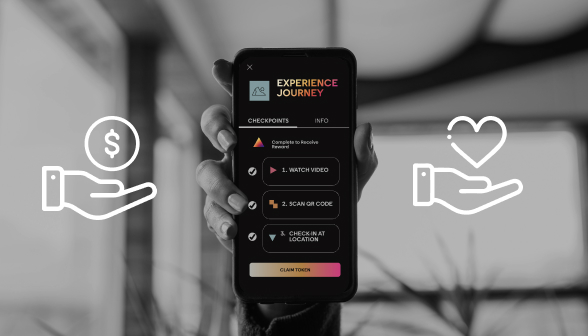Fast Track to Yes
Winning Support For Your Loyalty Program Investment

If you're reading this article, it's likely you already recognize the value and importance of loyalty programs in today’s business environment. The challenge, however, often lies in developing a budget that not only takes your program to the next level but also ensures its success. A well-planned budget is crucial, but equally important is gaining approval and buy-in from your organization. Convincing stakeholders that allocating the necessary budget and resources to your loyalty program will yield significant results, potentially more so than other projects in the enterprise queue, is a critical step.
Given the clear benefits and widespread acknowledgment of the importance of loyalty programs, as well as their potential impact on the bottom line, it raises a pertinent question: Why is it often challenging to secure funding approval and the necessary resource allocation for these programs?
Let's dive into the key considerations and steps to develop a budget that ensures the success of your loyalty program performance. By addressing these factors, you can build a compelling case for your loyalty program, demonstrating its potential to drive significant business growth and customer engagement.
Laying the Financial Foundation for Successful Loyalty Program
A well-planned budget is not just about allocating funds; it's about investing in a program that can significantly enhance customer engagement and drive business growth.
Outlined below are 8 key steps and considerations necessary to develop a budget that not only supports the success of your loyalty program but also positions it as a strategic asset in your organization's growth.
Members prioritize the availability of educational resources, workshops, and training programs as a crucial factor in their ongoing skill development and staying informed about industry trends. Professional associations often offer opportunities for members to achieve certifications, thereby boosting their qualifications and marketability in their respective fields.
In helping members to grow professionally through the use of these type of resources, groups can provide value beyond the monetary into the growth and development of member’s professional lives giving them a personal and symbiotic connection to each other.
1. Understanding Customer Lifetime Value (CLV): Existing Program: Evaluate the current CLV and how the loyalty program has impacted it. Allocate budget to areas showing the most significant return on investment.
New Program: Estimate the potential CLV increase that a loyalty program could bring. This involves analyzing industry benchmarks and competitor strategies.
2. Analyzing Program Goals and Expected ROI: Existing Program: Set clear goals based on past performance data. If the aim is to increase purchase frequency, allocate more budget towards engagement strategies like personalized offers.
New Program: Define realistic goals for the program. Initial budgets might be higher to cover setup costs, with a focus on long-term loyalty program ROI.
3. Market Research and Competitive Analysis: Existing Program: Continuously monitor competitor strategies and market trends to identify areas for improvement and innovation.
New Program: Invest in thorough market research to understand what competitors offer and what customers expect from a loyalty program.
4. Technology and Infrastructure Costs: Existing Program: Consider the costs of upgrading technology or integrating new features. This could include investing in advanced analytics or mobile app development.
New Program: Factor in the initial setup costs, including software platforms, data management systems, and integration with existing systems.
5. Marketing and Communication Expenses: Existing Program: Budget for ongoing marketing efforts to keep members engaged. This might include email marketing, social media campaigns, and promotional events.
New Program: Allocate a significant portion of the budget to awareness and acquisition strategies. This includes initial launch campaigns and ongoing promotional activities.
6. Rewards and Incentives: Existing Program: Analyze the cost-effectiveness of current rewards and adjust the budget to focus on high-value incentives.
New Program: Determine the types of rewards (discounts, exclusive experiences, etc.) and their associated costs. Balance between attractive offers and sustainable expenses.
7. Staffing and Operational Costs: Existing Program: Ensure adequate budgeting for staff training and program management, especially if expanding or enhancing the program.
New Program: Include costs for hiring or training staff to manage the program, as well as ongoing operational expenses.
8. Monitoring and Evaluation: Both Scenarios: Regularly review the program's performance against KPIs. Allocate budget for tools and resources needed for continuous monitoring and adjustments.
It's crucial to maintain a balance between creating value for customers and achieving a sustainable return on investment. Regularly revisiting and adjusting the budget based on program performance and market dynamics is key to the success of any loyalty program.
Investing in loyalty programs also ensures a competitive edge in the market. In today's digital age, where customers are bombarded with choices, a well-budgeted loyalty program can be the differentiator that sets a brand apart. For instance, Sephora's Beauty Insider program has been a game-changer in the beauty retail sector. By offering exclusive rewards, personalized recommendations, and unique experiences, Sephora has not only retained customers but also attracted new ones. This success is backed by a dedicated budget that supports continuous innovation in their loyalty offerings, keeping the brand ahead of its competitors.

Aligning Loyalty Program KPIs with Business Objectives
Now that we have identified the costs and potential returns of your loyalty program, the next crucial step is to craft your request in strategic business terms. This involves positioning your loyalty program investment as a top priority within the enterprise. The challenge lies in articulating the value and strategic importance of the program in a way that resonates with key decision-makers and stakeholders. It's about moving beyond seeing the loyalty program as a mere marketing tool and recognizing it as a vital component of the organization's overall strategic plan. This shift in perspective is essential for securing the necessary support and resources to make your loyalty program a driving force in achieving business objectives.
The key to successfully incorporating loyalty program KPIs into a Balanced Scorecard is ensuring these KPIs are in harmony with the overarching business objectives. For instance, if a business goal is to increase market share, a relevant KPI for the loyalty program might be the rate of new member acquisition or the percentage of sales attributed to loyalty program members.
It's crucial to select KPIs that are not only measurable and attainable but also directly influence the business's strategic goals. This alignment ensures that the loyalty program contributes meaningfully to the organization's success and doesn't operate in a silo.

Integrating KPIs into Each Perspective of the Balanced Scorecard
Financial Perspective: This might include KPIs like the program's ROI, the cost of acquiring and retaining a loyalty program member, and the increase in average transaction value among loyalty program members.
Customer Perspective: Here, KPIs could focus on customer satisfaction and retention rates, Net Promoter Score (NPS) among loyalty program members, and the frequency of purchases or interactions by loyalty program members.
Internal Process Perspective: KPIs in this area might involve the efficiency of loyalty program operations, the time taken to resolve member issues, and the effectiveness of the program's communication strategy.
Learning and Growth Perspective: This could include KPIs related to staff training and development in managing the loyalty program, the innovation rate in loyalty program offerings, and the effectiveness of data analytics in improving the program.
By integrating loyalty program KPIs into each perspective of the Balanced Scorecard, organizations can ensure a comprehensive and balanced approach to measuring and managing the performance and success of their loyalty programs. This integration not only helps in achieving specific program goals but also aligns these goals with the strategic direction of the entire organization, thereby driving overall growth and success.
Final Thoughts: The Transformative Power of Loyalty Programs in Business
Through our exploration of the strategic importance of loyalty programs as key revenue drivers, it's evident that these programs are much more than a marketing gimmick. They are a vital component of a business's strategy to enhance customer engagement, drive revenue, and maintain a competitive edge in the market. The transformation of loyalty programs from simple point-collection schemes to sophisticated, data-driven tools for personalization has redefined the way businesses interact with their customers.
Loyalty programs, when strategically developed and effectively managed, can be transformative for businesses. They are an investment in customer relationships that yield long-term dividends, driving growth, and ensuring sustainability in an ever-evolving market landscape. As businesses continue to navigate the challenges of the modern marketplace, the strategic edge provided by well-crafted loyalty programs will undoubtedly be a key factor in their success.
Thank you for your interest in our article. Happy reading!